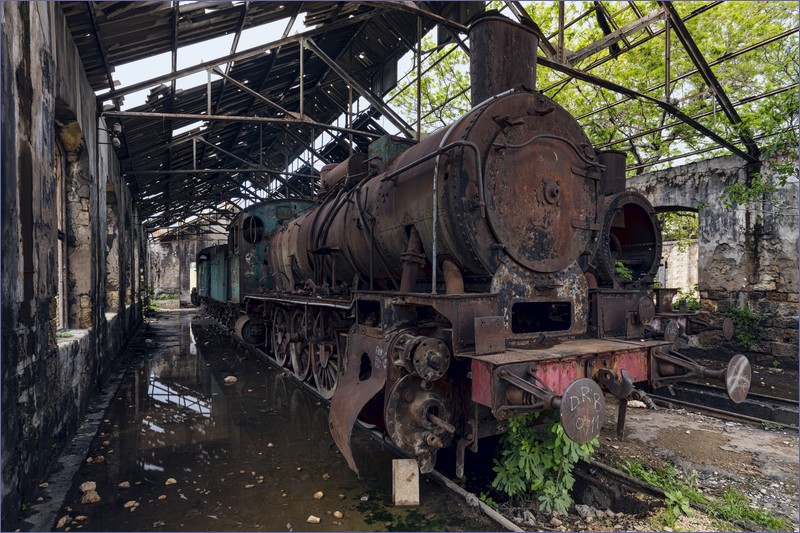There are no passenger trains in Lebanon. In the past, railway in Lebanon functioned very well. Traces of its heyday still remain to this day but many carriages, locomotives and elements of infrastructure were badly damaged during the civil war in 1970s. The last operational routes ended for economic reasons in the 1990s. At its peak Lebanon had about 408 kilometres of railway network.
Funicular railway in Jounieh
There is a funicular railway in Jounieh, a city located 16 kilometers north of Beirut. The Harissa Hill – a popular pilgrimage site to the Sanctuary of Our Lady of Lebanon dominates the city of Jounieh.
The steep hill can be accessed using both a cable car and a funicular railway. The funicular railway connects the upper station of the cable car with the summit of the hill. It actually goes right up to the top, although there are still a few stairs to climb.
The entire journey from Jounieh to the hilltop takes about 9-10 minutes. The funicular ride itself takes about one and a half minutes; during this time, the car covers a distance of 175 meters. The height difference between the starting and ending stations is 36 meters. The speed is two meters per second. At the same time, two cars run on separate tracks, each can accommodate 10 people. Both from the cable car and the funicular railway cars, as well as from the hilltop, there are breathtaking views of Jounieh and the bay.
Ticket prices for tourists are nearly three times higher than for locals.
Funicular and cable car in Jounieh – official website

Railways in Lebanon – history
Already in the 1880s, there were plans to build railways in present-day Lebanon, which was then part of the Ottoman Empire. The British explorer Laurence Oliphant proposed the construction of a railway line from Haifa to Damascus. Due to political reasons (the Ottoman Empire saw a threat to trade in the Lebanese ports), the British were forced to abandon the plan.
In the 1890s, the French engineer Edouard Coze proposed extending a railway line to the port of Tripoli, connecting it with the territory of present-day Syria.
In 1895, the first train ran from Beirut to the town of Rayaq. The line then continued to Damascus. The line was built to the unusual gauge of 1050 mm.
In 1906 the second line from Rayaq to Aleppo (present-day Syria) was inaugurated. It was built to 1435 mm gauge and change in Rayaq was required
In 1911, the Tripoli – Homs railway line was built. The line line was isolated from the rest of the system, The railway line which was destroyed by the Ottoman forces during World War I, and the dismantled tracks were used to construction of the Damascus – Baghdad line.
During World War II, the British built the Tripoli – Beirut – An-Nakura line, from where the railway continued to Haifa and further to Port Said and Cairo. The line was mainly used for transporting soldiers.
The Tripoli-Haifa line operated until 1948, when the Arab-Israeli War broke out. The An-Nakura – Beirut section was dismantled, while trains continued to run normally on the remaining part of the line (Beirut – Tripoli). The Orient Express train arrived in Beirut twice a week, and a railbus operated between Beirut and Aleppo.
On June 6, 1956, the railways in Lebanon were nationalized. State-owned company Chemin de Fer de l’État Libanais was established.
In the mid-1960s, the railway faced a crisis due to the increasing role of road transport.
In 1975, the Lebanese Civil War broke out. Passenger trains were suspended, and freight trains ran irregularly, mainly transporting fuel and essential goods.
Traffic on the Tripoli-Beirut line was suspended on February 15, 1979, after three bombs exploded in the town of Koura.
The southern part of the railway network was closed in December 1983 after intense shelling from Israeli territory.
In 1985, train services between Beirut and Al-Batrun were reinstated. The trains ran for a short period of time.
During the civil war, a large part of the infrastructure was destroyed and looted.
After the war ended on October 7, 1991, the “Train of Peace” was launched between the Daoura and Jounieh stations. It was a short route from the suburbs of Beirut to a city about 15 kilometers north of the Lebanese capital. Reconstruction of the railways was also announced. The “Train of Peace” operated for only 49 days.
Until 1997, trains ran from Beirut to the Shikka cement plant.
Since then, little has changed. Reconstruction of railway lines in Lebanon has been announced several times, but to this day, only fragments of tracks, abandoned railway stations, and individual locomotives and wagons remain.
Related articles:
